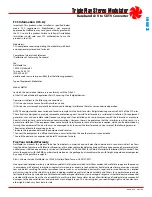
NetMedia, Inc., 10940 N. Stallard Place, Tucson, Arizona 85737 (520) 544-4567 Fax: (520) 544-0800 Email: [email protected] www.netmedia.com
Q- How do I find out if the modulator is working when I can’t see it on any televisions?
A- Start with a basic setup: connect modulator to coax and coax to a standard TV with no amplifiers, splitters, filters, cable boxes or
other devices involved. Set the modulator to a channel that matches the TV mode: 14-69 for Antenna tuning; 70-94 or 100-125
for Cable tuning. If the TV can tune channel 70 or above, then it is probably in Cable tuning mode. Set a simple channel like 20 or
120 and look for it on the TV. Check power, connections, cables, TV tuning mode, and modulator channel to correct any problems.
You must see the modulator output to confirm that it works in this basic setup before moving on to more complex setups.
Q- How can I view modulated signals on my security monitor or DVR?
A- Equipment that does not have a tuner, such as a security monitor, Quad display, or DVR, will require a demodulator (any TV tuner
device with a composite video output such as a VCR) for each modulated signal that you want to convert. To avoid this extra
expense and complication, you should modulate the signals after they are run through a monitor or DVR.
Q- How can I view modulated signals with high definition (HD) devices?
A- Proprietary, digital, or high definition (HD) tuners, including satellite receivers, cable boxes, and HD TV’s or monitors may require
a separate standard (SD) tuner, such as an SD TV or VCR. Satellite receivers often have an antenna input that is passed to an SDTV
tuner when the receiver is turned off. Cable boxes can be bypassed as described below. If the HD box, and TV or monitor does not
have an SDTV tuner then an additional device, such as a VCR, will be required to select any modulated channels for viewing
through the composite input of the TV or monitor.
Q- Why does the modulator or cable service picture go bad when the two are combined together?
A- The signals should be combined at the beginning of the distribution system before the cable service goes through any splitters.
Make sure you are not using any satellite diplexers to split or combine. Once done, there is either interference or the signals are
not balanced. Most interference comes from invisible digital data that is on the line even when not subscribed to it. First set the
modulator for clear channels, perhaps 120-125, or use a filter to remove any competing signals. Once there is no interference you
can balance the signals by amplifying the weaker, snowy one before the two are combined. +10 to +20dBmV is usually enough,
too much will degrade the other signal.
Q- Can the modulator be combined with digital cable service?
A- Yes. The difficulty is in finding a clear channel for the modulator. The digital data usually takes up the analog channel range of
80-117 so channel 120 is a good place to try. Analog 120 on the TV will not conflict with digital 120 on the cable box. If you cannot
find a clear channel then you will have to use a low pass or notch filter (NM-CNF7080) on the cable service before you combine
it with the modulator. The filter may remove analog channels but make sure it does not remove any subscribed digital services
including an Internet connection. If only one location is using the digital services and it does not need to see the modulator, you
can split its run off before the main line is filtered and combined with the modulator. This prevents the filter from disrupting the
digital data while enabling the modulator to appear on the rest of the TV’s.
Q- How can I view modulated signals with a TV that uses a cable box?
A- There are a few ways but they all involve bypassing the cable box and using the SDTV tuner to see modulated signals. Combine
the modulator with the cable service and check its picture by connecting the coax directly to the TV. Any splitters, filters, or
amplifiers you use for combining are separate from the ones used to bypass the cable box. After verifying the modulator picture,
split the coax two ways with one side going to the cable box. If you use the cable box S-Video, composite, or component A/V
outputs then the other side of the splitter goes directly to the TV. If you use the cable box coax output and there is only one coax
input on the TV, then you must use a ch. 3/4 filter (included with NM-ACB3) and recombine the coaxes as shown in Figure 4. In any
case, view the cable box through the appropriate TV connection, Video 1, ANT 2, channel 3/4, then change the TV (NOT THE
CABLE BOX) to the modulated channels.
Figure 4 - Bypassing a digital or analog cable box and recombining to a single coax input on the TV. The kit’s filter
removes any conflict on channel 3 or 4. Switch TV from the cable box to the modulator channels.
Frequently Asked Questions
NM-MM73S
MAN-MM73S REV0709A
Main cable or antenna
Splitter/
Combiner
Modulator
Optional NM-CNF7080 Ch. 70-80 Notch Filter
when there are no clear cable channels.
The notch filter does not bypass the cable box.
Television
Cable Box
NetMedia Cable Box
Bypass/Combiner
Kit NM-ACB3
The kit filter does not
make clear channels
for the modulator.





















